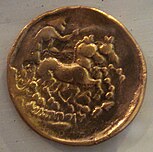
Back Sequaner ALS Секваны Byelorussian Секвани Bulgarian Sequani Breton Sèquans Catalan Sekvanové Czech Sequani Welsh Sequanere Danish Sequaner German Σηκουανοί Greek

Gold coins of the Sequani Gauls, 5-1st century BC. Early Gallic coins were often inspired by Greek coinage.[2]
Silver coins of the Sequani Gauls, 5–1st century BC.

The Sequani were a Gallic tribe dwelling in the upper river basin of the Arar river (Saône), the valley of the Doubs and the Jura Mountains during the Iron Age and the Roman period.[3]
- ^ Butler, Samuel; Rhys, Ernest (1907). "Map 4, Gallia". The Atlas of Ancient and Classical Geography. Everyman. London; New York: J.M. Dent; E.P. Dutton.
- ^ Boardman, John (1993). The Diffusion of Classical Art in Antiquity. Princeton: Princeton University Press. p. 308. ISBN 0691036802.
- ^ Schön, Franz (Regensburg) (2006-10-01), "Sequani", Brill’s New Pauly, Brill, retrieved 2023-12-16



